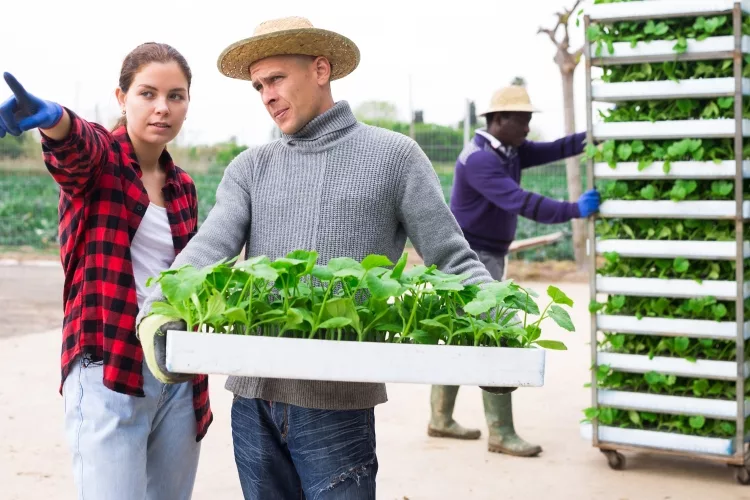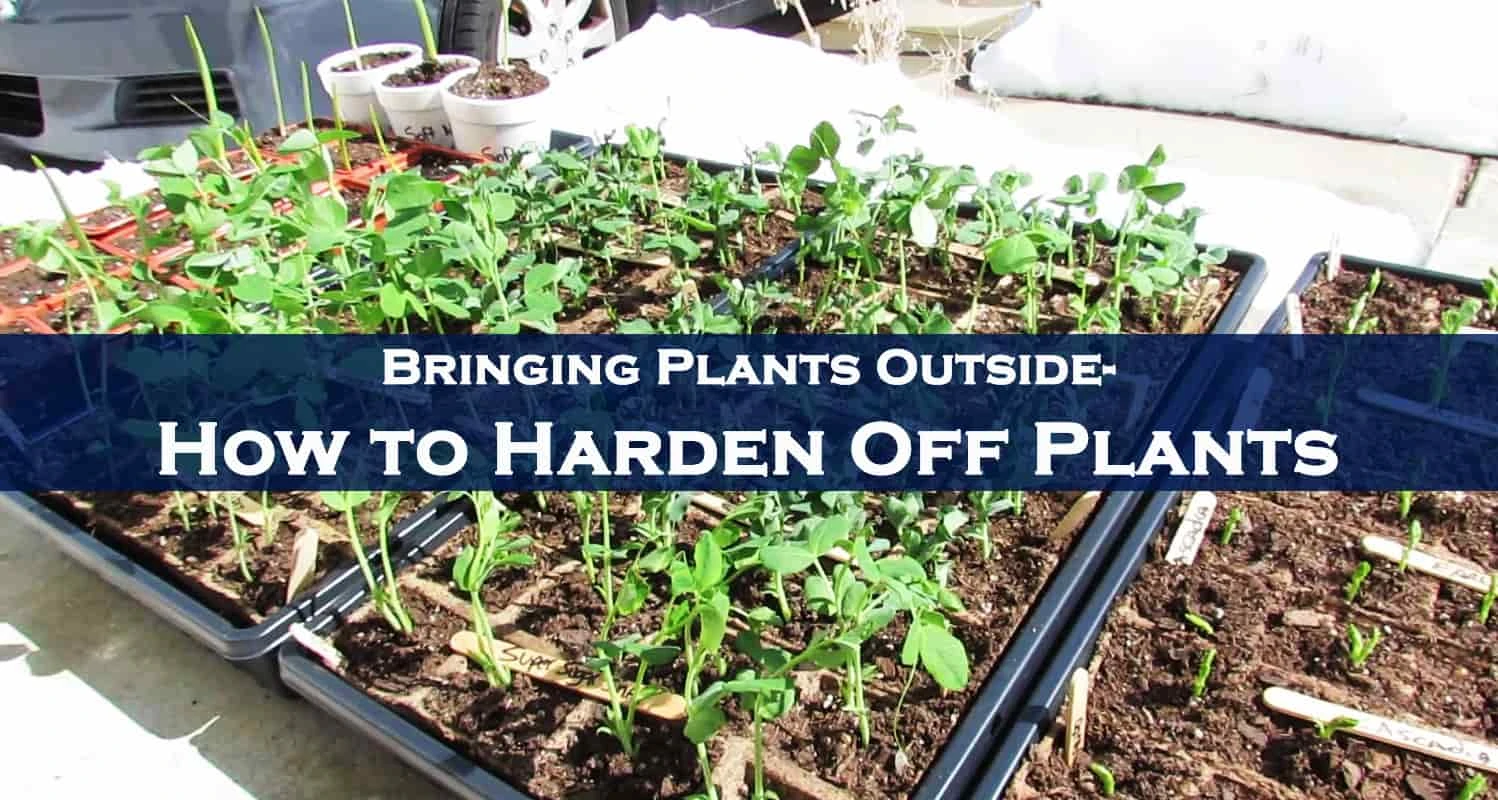reviewed by Christina Lopez
Growing your plants indoors from seed is a very controlled and nourishing environment. The outdoors is a drastic change from what your tender seedlings and young plants are used to. Before bringing them outside, it is essential to know how to harden off plants not to die or suffer from shock.
Hardening off plants is a gradual introduction to the new elements of the outside. This includes the variations in temperature, winds, and the UV light of the sun.
Contents

I have experienced it for myself and heard it many times from others. Beautiful, healthy seedlings and young plants transplanted into the garden only to wilt, break or die. It is a tragic tale that is avoidable by proper acclimation. Hardening off your plants takes a bit of effort but is 100% worth it.
This can also happen when you bring plants home from a nursery or a box store garden center. Often these plants have not had a hardening off period to the outdoor elements.
It is always better to err on the side of safety. Harden off plants you buy unless you are specifically told they have been acclimated.

Whitening of leaves or large white spots. The result is sunburn. Yes, your plants can get sunburn-like us, especially if they have not been exposed to the strength of the UV rays that true full sunlight emits. Windows, greenhouse glass, and grow lights do not emit the UV rays like the sun. This sudden introduction of UV can cause the outer layer of the plant tissue to burn up, leaving white spots. This can harm the plant’s ability to perform photosynthesis. Severe damage will result in death.
Although this can include other issues, often this indicates a weather shock. A cold weather shock can mimic a frost reaction in young plants that have never been exposed to temperature extremes. Their young leaves can wilt and brown due to the sudden change in ambient air temperature.
Young seedlings that have not been exposed to any air can be easily be damaged by even mild winds. You can help prepare them in advance by running a low fan on them indoors as they grow. The constant force will encourage strong stem growth. Hardening off gradually also prepares them further for the influence of winds in your area. Offer tall plants additional support when you plant them.
Hardening of your plants should take 10 to 14 days. In some cases, you may decide to take a little longer if your weather conditions in the evening may be too excellent for immediate transplanting. Try to stick with the schedule of exposure as much as possible.
You will need to pick the first area carefully as this will be the most sensitive time for your plants. This will need to be a shady, sheltered area that gets minimal to only filtered sunlight throughout the day. A covered porch on the north side of your house that gets little to no direct sunlight. A picnic table that you could put in a location that the underside would remain shaded through most of the day. Or possibly setting up a canopy shelter.
You will also need a box, wagon, or larger pots to hold the smaller transplant containers. This will help you transport plants inside and out and offer them support from being tipped over by the wind.
Always make sure your plants are watered well during the hardening-off process. Air temperature and wind will cause more significant water loss. Could you bring them back inside at night?
Bring your plants out during the day to your shady location. Make sure there is no danger of extreme temperatures or frost. Bring them in before dusk when temps are still warm.
Bring your plants into exposure to some morning or early sunlight for about an hour, two at most. Move back to shade for the remainder of the day. Bring in a little later in the evening but before dark.
Give your plants 2 hours of the morning sun, shade, and 2 hours of the later afternoon sun. If the evening temperature is warm enough, allow plants to remain until dark before bringing in.
Increase sunlight by 1 hour each day. Monitor your plants for any signs of stress. The increased sun can cause drying of the soil; oversee watering. Try to stretch the length of time they are exposed to the dark evening air before bringing them in. By day 8, if the night temp is 50 or above, leave them out.
After the 10 days, strong seedlings and plants that show no signs of stress can be safely transplanted into the garden or container.
Continue to increase sunlight gradually for those tender seedlings that need more adjustment time. They should be strong enough to be left outside now if temps at night are not too low. Suppose the plants are showing too much stress. Reduce them to shade for a few days and nourish them with fertilizer. I always recommend worm casting or worm casting tea. Follow this link for a review regarding worm castings’.
Work schedules can hinder the ability to move plants through-out the day. You can choose locations or a location in your yard that mimics the lighting conditions of partial sun and shade if needed.
√ Acclimating or acclimation is the hardening process. It is the adjustment made by a plant or organism to a change in environment or condition. You can learn more about the details of Acclimatization by following this link to Wikipedia.
√ In colder growing zones, cool nights can impact warm-weather plants like tomatoes, peppers, and eggplants. Consider cloche or a cold frame as a part of your hardening off process or even in your garden to better help them harden off.
√ Don’t Rush the process. I know you’re anxious to get your plants in the garden. Hardening off can also seem tedious at times. It is worth it, though. More robust, healthier plants! That means fewer issues all growing season. Your garden is worth it!
√ Nourish your babies before and after acclimating. Fertilizing is likely something you have already been doing indoors as your seedlings have been growing. Before hardening off and during transplant, give them an extra nourishing boost with natural fertilizers that do not harm. Remember, chemicals can burn when used in excess. Even some animal manures can cause fertilizer burn. I highly recommend worm castings’ sprinkled or made castings tea. This natural nourishment will give them a healthy boost as they transition.
Nourish Your Seedlings, Transplants & Garden With A Natural Fertilizer They Can Use Immediately & Safely
Worm castings are a safe, natural option to provide your plants with the nutrition they need at all stages of development. They do not burn, harm your soil or take time to be used. Your plants can use the power of worm castings right away. You are making them the best way to feed your growing garden.
When learning how to harden off plants, you ensure the next best healthy step for your plants. They will thank you with less stall in growth when transplanting and more robust growth through the season. This, in turn, leads to greater yields in the future.
I have mentioned it in previous articles as well. Healthy plants are more pest and insect resilient. They have a better chance of fighting mold, fungus, and bacterial illnesses. Healthy plants can recover better from extremes in weather.
A bonus from healthy plants is a future generation of vigorous plants. You are enabling strong seed production for better future generations and offsprings of your garden as well.
Growing a garden is a lot like raising children. The more you prepare them for the different stages of their life, the better parents they will later become in the future.
Please drop your comments below and let me know how things are going in your garden and plant acclimation.
Happy Growing Friends!
 |
 |
 |
 |

About Christina Lopez
Christina Lopez grew up in the scenic city of Mountain View, California. For eighteen ascetic years, she refrained from eating meat until she discovered the exquisite delicacy of chicken thighs. Christina is a city finalist competitive pingpong player, an ocean diver, and an ex-pat in England and Japan. Currently, she is a computer science doctoral student. Christina writes late at night; most of her daytime is spent enchanting her magical herb garden.
 |
 |
 |
 |
Check These Out
Get new FREE Gifts. Or latest free growing e-books from our latest works.
Disable Ad block to reveal all the links. Once done, hit a button below
 |
 |
 |
 |